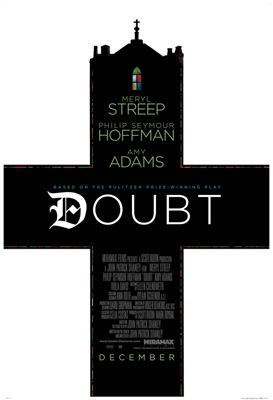Box Office Review: Doubt [2008]
Reviewed by Richard Lee Zuras
Released Dec. 25
I hr. 44 min.
PG-13
John Patrick Shanley/Miramax
Meryl Streep
Philip Seymour Hoffman
Amy Adams
Viola Davis
 Some films have divining rods built into them. It may be argued that a film such as Doubt has such a rod. After all, who among us that has been raised in or amongst those who attended Catholic school can resist a film that places at its heart that one nun that scared the *^%@ out of everyone? For those raised in the 1960’s, or for those steeped in its cultural uprisings, another rod, therein, built-in. This film takes place right there, in 1964, amongst the JFK assassination aftermath, amongst the beginnings of de-segregation, amongst the new role of the American woman, amongst the shift toward secularism, even amongst the shakeup known as Vatican ll.
Some films have divining rods built into them. It may be argued that a film such as Doubt has such a rod. After all, who among us that has been raised in or amongst those who attended Catholic school can resist a film that places at its heart that one nun that scared the *^%@ out of everyone? For those raised in the 1960’s, or for those steeped in its cultural uprisings, another rod, therein, built-in. This film takes place right there, in 1964, amongst the JFK assassination aftermath, amongst the beginnings of de-segregation, amongst the new role of the American woman, amongst the shift toward secularism, even amongst the shakeup known as Vatican ll.
That being said—this is a film that also reaches out to those who are younger, and less informed of The Church and/or the counter-culture movement. In an example of where casting meets script, Streep and Hoffman and Adams and Davis all bring to bear a humanity not often glimpsed in daily life. Each of these characters is real—even palpable. Like their Tony nominated counterparts in Shanley’s original play, these actors all secured Oscar nominations. Streep is likely to win. Davis is a discovery waiting to happen. Adams is unique in her charms, and Hoffman’s gravitas has become bankable.
This film is a work of Art—even if it is, at times, clearly in the wrong kind of theater (perhaps the Pulitzer winning play will find a well-deserved revival). No matter. The performances are strong enough to make up for its lack of forward motion and quick cuts we have become so accustomed to viewing. Hitchcock used to lament that before he came along, Hollywood was nothing more than filmed stage plays. He was right, of course. And in many ways Doubt is little more than that. The end, I might add without spoiling, also smacks of the stage. This is a film that follows Poe’s (fiction) advice that the work follow the theory of single effect. Doubt achieves this end with perfection. One effect should be stated early on, and everything in the work of Art should follow. It does. From the opening moments of the film Shanley tells us we will be exploring the idea of doubt—of having doubts about matters of extreme importance. To follow Poe’s advice and refer you to my opening salvo: did the followers of Catholocism, or at least Shanley himself, have built in doubts during the reform of Vatican ll? It is a question the film may pose, but it does not claim to answer.
On the surface its draw is also its timing coming in the decade that has seen many accusations and uprisings amid the sexual scandals of the Catholic Church. That it doesn’t mine these for cheap effect and ticket sales is another accolade of its fine scope and script. That it has made back its $25 million budget in four weeks of wide release—in this day and age of cheap, empty, popcorn movies—is nothing short of a welcome miracle.
Bottom line 4.0/5.0

